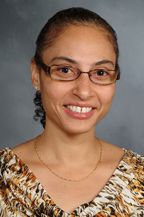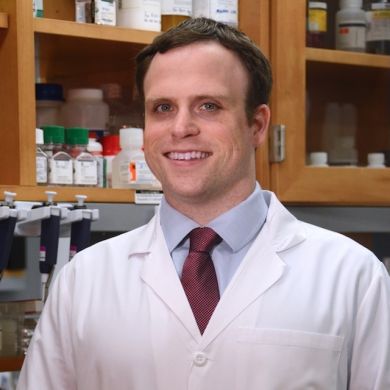What are the long-term health effects of living in space?
This is an excerpt of an article that appeared in the LA Times. Read the full story here.
Dr. Francine Garrett-Bakelman arrived at NASA’s Johnson Space Center in the middle of the night, ready to get her hands on Scott Kelly’s blood.
She watched on a laptop as the astronaut stepped off a plane March 2 about 1:30 a.m., back in Houston after his record 340 days aboard the International Space Station. Then, in a nearby molecular biology lab, she set the centrifuge to the right temperature and looked over her pre-labeled test tubes.
Within an hour, a NASA staffer brought in two samples — one drawn just minutes before, and the other taken during Kelly’s final hours in orbit.
The physician-scientist shifted into high gear: Blood doesn’t keep forever, and every minute counts. So does every drop — these tiny samples had to be split among several research groups.
“It’s a big responsibility, because you have four to five teams that are depending on you,” she said.
The blood work is part of the NASA Twins Study, an ambitious research project that explores the long-term health effects of living in space. Understanding those risks — and finding ways to mitigate them — will be crucial if NASA makes good on its pledge to send astronauts to Mars by the mid-2030s.
Scott Kelly, who circled the globe about 16 times each day, is only half of this unusual experiment. The other is his identical twin, Mark Kelly, a former member of NASA’s astronaut corps who spent the last year planted firmly on Earth. By studying both men at the same time, researchers hope to pinpoint the biological consequences of spending nearly a full year unshielded from radiation and untethered from gravity.
Space-farers experience well-known changes in microgravity: They get an inch or two taller, their faces puff up, and their bones become porous and weak. But the 10 teams participating in the Twins Study are going deeper, examining factors related to cancer risk, cardiovascular disease and immune system function.
That’s why Garrett-Bakelman spent six hours carefully processing Kelly’s blood — spinning test tubes, separating plasma and pulling out different cell types one by one. She didn’t finish until 8 a.m.
“It’s very surreal,” she said of the otherworldly feeling of handling blood drawn in space. “It’s a once-in-a-lifetime opportunity.”
The idea for the study came from Scott Kelly himself, said Craig Kundrot, life sciences lead at NASA’s Office of the Chief Scientist in Washington. The agency was making plans to track the health of Kelly and Russian cosmonaut Mikhail Kornienko over the course of the mission when Kelly asked whether any research would involve his brother, who flew four missions on the space shuttle.
“Our immediate response at the program was no,” Kundrot said. It was well past the usual window for soliciting research proposals.
But identical twin astronauts do not come around often. So NASA scrambled to put out a call to scientists.
The result was a collection of projects spanning physiology, microbiology, genomics and behavioral health.
One study out of Stanford uses flu vaccines to investigate how Kelly’s immune response changes in space. Two others, from Johns Hopkins and Cornell, examine the mechanisms underlying how gene expression changes in orbit.
Additional groups are analyzing how the gut microbiome fares in space and searching for molecular signals linked to problems that may result when the body’s fluids, freed from gravity, rush toward the head.
The leaders of the 10 chosen projects were called to the Johnson Space Center more than two years ago. Many had never worked with the space agency before.
UC San Diego molecular geneticist Brinda Rana, leader of the body fluid study, thought she might get a sample of about 10 milliliters of blood — a vial’s worth — each time the Kellys were sampled.
It quickly became clear that NASA would treat Scott Kelly’s biological samples like the moon rocks gathered by Apollo astronauts — precious scientific resources that must be doled out sparingly and shared by many.
NASA officials were polite but firm. Rana recalled the gist of their message: “You’re only going to get one vial of blood during each session, and you’re going to have to share that vial of blood between all 10 of you.”
One reason for their thrift was that Scott Kelly’s blood had already been promised to several other experiments. Up against NASA’s strict safety limits, he had little left to give.
So the Twins Study researchers spent months adapting their research routines to use every last drop of blood they were allowed.
The protein-rich plasma would go to Stanford University, where Michael Snyder was compiling a full chemical profile of the human body, including Kelly’s genome, proteome,transcriptome and metabolome. Several types of white blood cells — mainly certain B cells and T cells — would be shared by several teams.
“We became like a family,” said Dr. Andrew Feinberg of Johns Hopkins University, leader of a study on the twins’ epigenetic markers.
...
Once Kelly was in space, some blood samples could be frozen, but others needed to be processed first. The astronaut timed his blood draws so his samples could hitch a ride to Kazakhstan on a departing Soyuz spacecraft, then be whisked halfway around the world to Houston. That way, the blood could be processed within 48 hours of exiting Kelly’s arm.
...
The scientists put their trust in one another. One of them, such as Garrett-Bakelman, often processed and divvied up samples for several other groups.
Weill Cornell Medicine geneticist Christopher Mason, leader of a study on gene regulation and RNA modifications, said he often sent his colleagues samples that were just a few hundred microliters in volume.
“Sometimes it’s frozen, and then when you thaw the blood, a lot of your cells have died,” he said.
...
The scientists have held off testing most of the twins’ biological samples for months, waiting to collect a few more from both Kellys on the ground. This is a precaution to avoid what are known as “batch effects,” variations that can crop up because of tiny differences in the way samples are handled.
“It’s sometimes a challenge because we’re all anxious to see what’s going to come out of this,” Vitaterna said. “But it’s better science to wait and do it all together.”
With Scott Kelly’s last “integrated” sample being taken this week, that prospect is finally within reach.
....




